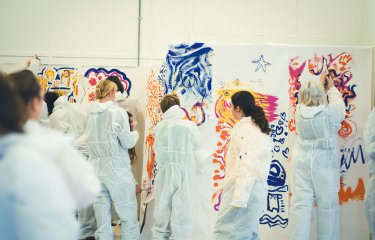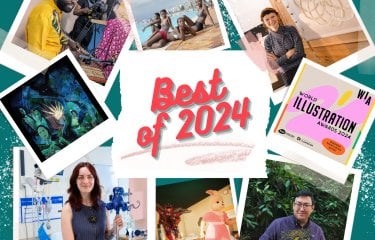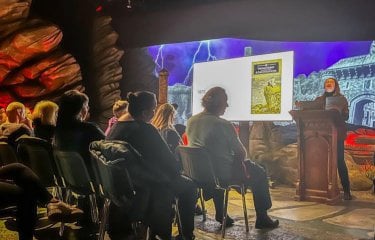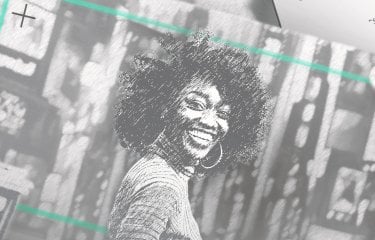Photography Lecturer Exhibits Historic Project in South Korea
13 February 2019
You can never be sure exactly where a creative passion project will take you. Andreas Sterzing, Senior Lecturer on the BA(Hons) Photography course, knows this particularly well.
A project he thought long-forgotten – photographs documenting the creative community of New York’s East Village in the mid-1980s – has come back into the light and has recently been exhibited at the Seoul Museum of Art, a well-established museum gallery in South Korea’s capital.
At its peak, there were over a hundred galleries in the East Village. They would pop up and disappear quite frequently, showing boundary-pushing art by the East Village artists. The exhibition in Seoul captured the moment. It featured work by artists from the time, such as Jean-Michel Basquiat and Nan Goldin, and included paintings, illustrations, films and photography.
Describing the East Village as a location, Andreas told us: “It was a very run-down neighbourhood at the time. There were buildings burning and abandoned, but the rents were cheap, which is why we were there.”
The Seoul exhibition motto was a quote by Gracie Mansion, the curator (and East Village gallerist): “It seemed to be a time of no limitations. Everything was possible. More than that, it was probable.” Andreas’ work – a digital slideshow of images – has a prominent place at its centre.
“[My slideshow] works well within the exhibition because it puts all the artwork that’s displayed in context,” Andreas told us. “It shows the culture, the place, the people and the life; how it was at the time. It’s almost like the glue that holds this whole show together.” His photographs illustrate the story; some even show the artists in mid-flow creating work.
Andreas smiled: “It’s a pleasure and an honour to be part of that group of artists and people who are in that exhibition. And it’s wonderful for the work to be recognised in a museum.”
Andreas’ East Village slideshow in Korea follows on from a different slideshow, of photographs of the Pier 34 project and the artists who worked there, which has been exhibited as part of a retrospective of the work of David Wojnarowicz, at the Whitney Museum of American Art in New York and currently at the KW Institute for Contemporary Art in Berlin.
It all started in 1982, when Andreas moved from Germany to New York to kickstart his photography career. He was in his mid-20s and hungry for new experiences. Keen to step into the field of editorial photography, he was on the look-out for a good story.
Andreas recalls: “I was looking for something to enhance my portfolio and help me get into magazines. I had heard about this pier where artists were working, and it sounded intriguing.”
The Pier project was started in 1983 by David Wojnarowicz and Mike Bidlow, who were part of the downtown New York art scene.
Long-abandoned, Pier 34 on the Hudson River was a place where creatives from the East Village community were doing work on a massive scale, free of rent and any control or limitations. Artists from all disciplines gathered there, making and collaborating in a variety of media: fine art, painting, drawing, photography, sculpture, multimedia, film (documentary and fiction), writing, street art, street performance, poetry, music…
Andreas started documenting it immediately.
“The pier was a run-down building, falling to bits, dangerous to be in, but to me it felt like being in a different world,” he told us. “And I met people there right away.” He photographed the artists, the building, the neighbourhood and the art explosion that followed.
Andreas explained: “Instantly I became part of that group. It was very friendly and everybody was open and collaborative; it felt really comfortable. I was hooked. Every time I went there, something would have changed. In a room, suddenly there would be art where there was nothing before. If it would rain or snow, it would be on the ground; it was a part of nature. A completely different world from the outside, from the world of New York City.”
But the phenomenon was short-lived.
In 1984, the pier was torn down. By 1986, the East Village art scene was fading. The AIDS crisis had engulfed New York, with devastating effect. Many artists died very young. The crumbling East Village was rebuilt. The Pier project was forgotten.
A generation later, there is renewed interest in the downtown New York art scene of the late 1970s and early to mid 1980s. In 2016, when Andreas was invited to exhibit his work in New York, his photographs of the artists and the Pier were widely praised.
As part of the rediscovery project, Andreas contacted the surviving artists, interviewing them about the Pier and the work they created there. Many of the artists were in their mid-20s back then, at the very start of their careers.
Andreas told us: “Everybody I spoke to said that ‘this was one of the most important things in my life’. And it’s true, for me and everybody who was there. It was a decisive moment.”
“We were all young and open to everything," Andreas said. “We weren’t influenced by money, it was really about a community; it was just amazing. We were all hungry; artists are hungry for fame, for recognition. We all wanted success, but the success itself wasn’t as important as doing it and being there. It was a time when everything was possible.”
When he originally took the photographs in the 1980s, Andreas had no idea what would happen with them. “It’s not why I did it,” he said. “I did it because I was totally into it.” But it did lead him to his dream career in editorial photography. Photographs from the Pier were published in several magazines and got him work with publications around the world.
His advice for new practitioners? “When you start, follow your instincts and your passions. Always make work that you believe in and feel strongly about, because that is something that will remain strong and will survive for a long time. And don’t be discouraged by the competition out there, or if success doesn’t come right away. Keep going.”
This exhibition in Seoul highlighted to Andreas that “if you’re really passionate, really confident about what you’re doing, it will lead to something. You just don’t know what it is at the time.”










